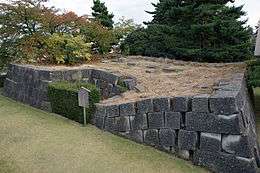1948 Fukui earthquake
The 1948 Fukui earthquake (福井地震, Fukui jishin) occurred in Fukui Prefecture, Japan. The magnitude 6.8 quake struck at 5:13:31 p.m.(JDT) on June 28. The strongest shaking occurred in the city of Fukui, where it was recorded as 6 (equivalent to the current 7) on the Japan Meteorological Agency seismic intensity scale. The shock occurred near the town of Maruoka.[6]
 A collapsed stone wall at Fukui Castle | |
  | |
| UTC time | 1948-06-28 07:13:31 |
|---|---|
| ISC event | 897413 |
| USGS-ANSS | ComCat |
| Local date | June 28, 1948 |
| Local time | 16:13:31 JST |
| Magnitude | 6.8 Mw[1] |
| Depth | 10 km (6.2 mi)[1] |
| Epicenter | 36.16°N 136.22°E[1] |
| Type | Intraplate earthquake |
| Areas affected | Japan |
| Total damage | US$ 1 billion[2] |
| Max. intensity | MM IX[2] Shindo 6 |
| Casualties | 3,769 dead[3][4][5] 22,203 injured [4][5] |
Geology
This earthquake was caused by a strike-slip fault that was unknown until this earthquake. The fault stretches from Kanazu to Fukui,[7] 25 km (16 mi) long, and was later named the "Fukui Earthquake Fault". Shaking was felt as far as Mito in the east, and Saga in the west.
Damage

Damage was most reported in the Fukui plain, where the building collapse rate was more than 60%, since shaking became larger due to it being an alluvial plain, and many of the buildings were just built after the war and a little unstable.
At the time many people were cooking so after the earthquake many fires spread. Since the roads and the waterworks were damaged it took 5 days to put out the fires and so the fires caused devastating damage.
Even though the Daiwa Department Store collapsed, the Fukui Bank building right next to it had no significant damage. It is thought to have been because the Fukui Bank building had about 500 deep foundation pipes 10 meters deep in the ground.
Almost all of the farmers' houses in the epicenter area collapsed, but most of the farmers were outside so there were not many casualties.
| Prefecture | Casualties | Damaged houses | |||
|---|---|---|---|---|---|
| Deaths | Injuries | Collapsed | Half collapsed | Burned | |
| Fukui | 3,728 | 21,750 | 35,382 | 10,542 | 3,851 |
| Ishikawa | 41 | 453 | 802 | 1,274 | 0 |
| Total | 3,769 | 22,203 | 36,184 | 11,816 | 3,851 |
Damage in Fukui City
| Dead | 930 |
|---|---|
| Collapsed buildings | 12,270 |
| Half collapsed buildings | 3,158 |
| Burnt buildings | 2,069 |
| Building collapse rate | 79.0% |
| Fires | 24 |
| Burnt area | 2,120,600 m² |
Casualties
At the time, it was the deadliest earthquake after the Pacific War (now superseded by the Great Hanshin earthquake and the Tōhoku earthquake and tsunami). This earthquake killed 3769 people, mainly in Sakai City (then part of Fukui City), where the death rate was more than 1%.
Property damage
- Maruoka Castle collapsed.
- Hosorogi Station and Kanazu Station (now Awaraonsen Station) collapsed.
- The Daiwa Department Store collapsed.
- A theater in Fukui collapsed and caught fire, killing a few hundred people.
Other
- Levees damaged by the earthquake and torrential rains caused Kuzuryū River to overflow.
Influence
- The Japan Meteorological Agency added Shindo 7 to the Japan Meteorological Agency seismic intensity scale.
References
- ISC (2015), ISC-GEM Global Instrumental Earthquake Catalogue (1900–2009), Version 2.0, International Seismological Centre
- "Significant Earthquake".
- "Archived copy". Archived from the original on 2013-01-19. Retrieved 2012-12-24.CS1 maint: archived copy as title (link)
- http://www.jishin.go.jp/main/yosokuchizu/chubu/p18_fukui.htm#kakojishin
- http://www.jishin.go.jp/main/yosokuchizu/chubu/p17_ishikawa.htm#kakojishin
- Japan Meteorological Agency Shindo Database Search Retrieved August 16, 2008
- "Archived copy". Archived from the original on 2016-04-20. Retrieved 2012-12-25.CS1 maint: archived copy as title (link)
- 宇佐美龍夫『新編日本被害地震総覧』東京大学出版会、1987年
External links
- Earthquake in Japan: June 1948 – slideshow by Life magazine
- The International Seismological Centre has a bibliography and/or authoritative data for this event.